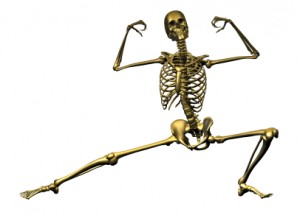Ask Kat: How Do I Get Enough Calcium Without Dairy?
Read time: 3-4 minutes

Question: How do I get sufficient calcium if I don’t drink dairy and I have a high case of low bone density within family members? I know leafy greens have it but what else? Thanks 🙂
Kat: There are two key points that I’d really like to touch on here. Firstly, the misconception that dairy consumption is the best way to get your calcium and improve bone density, and secondly the answer to your question, namely how you can get sufficient calcium.
the dairy myth
I’m all for adequate levels of calcium in the body, but I have a bit of a personal issue with why calcium has become such a focal point for health enthusiasts. While many of us are becoming aware of the importance of a range of minerals and nutrients – vitamin D, omega 3, and magnesium are all commonly discussed in terms of their importance to ideal health – the health world dairy industry and therefore media focus on calcium would have us all believe that it’s the answer to just about everything. Can you honestly say you would be so concerned about your calcium levels if it weren’t for the focus put onto how much dairy we supposedly must consume? Have you ever anxiously wondered how your manganese levels are doing? How about selenium – so crucial to thyroid health and optimal neurotransmitter function? What about copper? Zinc? Methylators? Iodine? Chromium? Maybe. But probably not right, or at least not to the same degree as calcium. Just something to think about.
Rant over (and please be assured I am absolutely NOT anti-dairy, in fact I use (raw, organic) cream and butter as a daily staple in my home but I do minimise my milk intake), let’s talk about why dairy might not be the answer to your calcium needs.
The following excerpt from UK site ‘The Healthier Life’ sums up my personal feelings on the so-called health benefits of milk quite nicely.
“According to US HSI Panel member Dr Allan Spreen, there is a long list of reasons why milk is unhealthy or at least not the solution we’ve been told, including:
- calcium in milk is not well absorbed (and even less so once homogenised);
- there isn’t enough magnesium in milk;
- there’s evidence that the antibodies the body makes to milk are closely related to the antibodies that destroy islet cells (insulin producers) in the pancreas in cases of juvenile diabetes (!!);
- homogenisation breaks up the enzyme xanthine oxidase, which in its altered (smaller) state can then enter the bloodstream and react against arterial walls, causing the body to protect the area with a layer of cholesterol (!!);
- the fat content of milk is for the accelerated growth of calves; and
- milk contains pesticides, herbicides, fertilisers, and Bovine Growth Hormone.
Dr Spreen does, however, add that cultured products (kefir, yoghurt), and enzymatically-altered products (cheese, etc.) are acceptable calcium rich foods in moderation (and possibly butter, too).
For the sceptical side of you – this is by no means a sole opinion. A simple Google or pubmed search will reveal page after page of similar research and discussion.
Side note: Personally I’m a huge fan of raw butter and cook with it frequently. The short-chain fatty acids are excellent for a healthy metabolism, and the butyric acid increases all-round nutrient absorption.
is calcium really the answer anyway?
According to Biosignature founder Charles Poliquin it’s by no means an accepted conclusion that calcium increases bone density without other important factors. In this very useful article on bone health, Charles states the following:
“Sure, there are studies out there that suggest calcium increases bone density, but the problem is that those studies always included other variables like exercise and vitamin D. (These are certainly) two factors that have been shown independently to improve bone health, (but) osteoporotic bone isn’t just lacking adequate calcium, it has also lost magnesium, manganese, zinc, copper and most importantly, collagen.”
Hmmm. I don’t know about you, but to me it sure as heck makes sense that one nutrient alone couldn’t be the ‘be-all-end-all’ for something as important as bone health. If you’re a research and learning based kinda person and you want to be sure you’re not missing half the story on this important issue then I’d strongly suggest you also check out the following article by Charles:
Magnesium Deficiency: A Growing Health Crisis
Here’s a small excerpt on osteoporosis:
“The primary message coming from the dairy industry is that you need calcium for strong bones and to help prevent osteoporosis. True, but you can’t have healthy and strong bones without adequate magnesium. The ratio of calcium to magnesium in the diets of the Paleolithic man was 1.3 to 1, but the diet that is commonly used now has shifted that ratio to 5 to 1. The main culprit is the inclusion of dairy products in the modern diet. The calcium-to-magnesium ratios found respectively in milk, yogurt and hard cheeses are 7:1, 11:1, and 26:1.”
Charles goes on to discuss an important study in which magnesium supplementation directly improves subjects bone density.
okay, okay – but calcium still matters, right?
For sure. I absolutely do not mean to imply that it doesn’t. It matters just as does pretty much every vitamin or mineral you might care to name – each to different degrees perhaps, and for different purposes most certainly. So let’s talk about how or where you can best get your calcium – the most useful and absorbable kind of course!
The following chart, which I found on this site, lists some excellent food sources of calcium.
| Whole Food Sources | Serving | Calcium (mg) |
| Sardines | 3 ounces | 372 |
| Chinese cabbage, cooked | 1/2 cup | 239 |
| Spinach, cooked | 1/2 cup | 230 |
| Rhubarb, cooked | 1/2 cup | 174 |
| Wild salmon, canned with bones | 3 ounces | 167 |
| Kale, cooked | 1 cup | 122 |
| White beans, cooked | 1/2 cup | 113 |
| Bok choy, cooked | 1/2 cup | 79 |
| Broccoli, cooked | 1 cup | 70 |
| Pinto beans, cooked |
1/2 cup | 45 |
| Red beans, cooked | 1/2 cup | 41 |
One ounce is about 28 grams.
In general it’s true that the darker and leafier the green vegetables, the more calcium it contains. A bonus is that eating oily fish and dark green vegetables is a boost for many aspects of good health, including omega 3 intake and estrogen detoxification, so I’d certainly recommend you include these foods.
The other thing you may like to consider is supplemental support for bone density. If you’ve read this far then you’ll guess I’m not talking about a pure calcium supplement! But even if I were, it’s important to realise that there are different forms of calcium. The most absorbable form is called Hydroxyaptatite, and it’s been shown to actually increase bone density. Other forms – cheaper forms typically used in over the counter supplements – may slow or even stop bone loss, but won’t reverse it. The Poliquin Bone Matrix supplement contains Hydroxyapatite, along with type I and II collagen, in addition to zinc, copper, manganese, magnesium, vitamin D, and a range of other bone building nutrients – it’s absolutely my recommendation of choice, and each tablet has over 400mg of calcium! A very simple way to ‘insure’ your bones.
You are (not?) what you eat
Finally, remember that the old adage ‘you are what you eat’ can be more accurately defined as ‘you are what you eat and digest’. It’s all very well to choose the most nutrient-dense foods and supplements, but it’s no good to you if you’re not absorbing those nutrients thoroughly. If you suspect digestion may be an issue for you then I’d suggest having it assessed through a Biosignature consultation.
Over to you – is this the first time you’ve heard the idea of milk not being ‘all it’s cracked up to be’? What’s your take on the matter?

Hi Kat! I agree 100%. Especially in America the emphasis is on calcium and vitamin D when the problem is all the other foods that are causing these deficiencies. I don’t think we would feel the need for so much emphasis on calcium if the food pyramid weren’t taught recommending 6 servings of grains daily and Coca Cola and Pepsi didn’t run half the adds on TV – which our children are glued on. It’s an endless cycle of media driven propaganda here in the states. It’s so incredibly frustrating that the media overrides true information on the subject of nutrition. I am just happy that Elena will still gobble down a cup of cooked spinach in a heartbeat! We do a bottle of raw milk once in a while which I use the cream from, but most importantly is getting all the nutrients needed from real food and other supps before resorting to milk.
Would you be able to post more about sources of magnesium as well? I notice a HUGE difference when I take Magnesium Glycenate daily – I feel like I’m properly absorbing vitamins and minerals from my food when I take it.
Love the posts! Especially your workout video! Keep ’em coming!
That’s interesting; I haven’t used glycinate by itself consistently .. I use the Poliquin ubermag to help me sleep; which has a blend of 4 chelates. I am planning to reprint a Poliquin article on magnesium next week actually – he has so much good stuff to say that it’s pointless my rehashing it! Sounds like you’re doing such a great job with Elena 🙂
Oh – bet you can’t wait to see the full workout vid, hey? Neither can I!!!